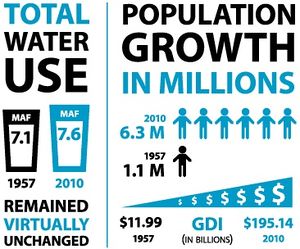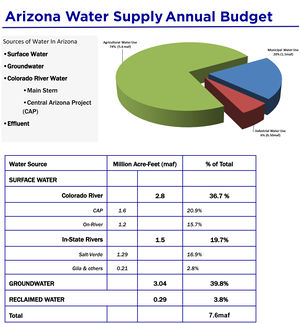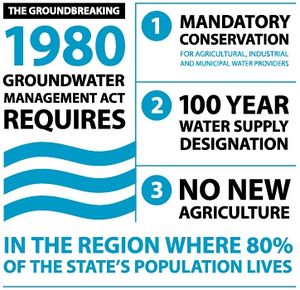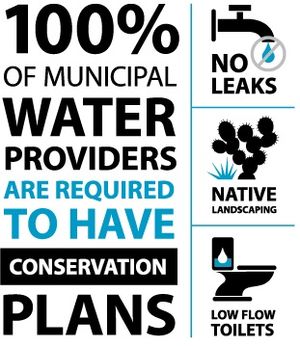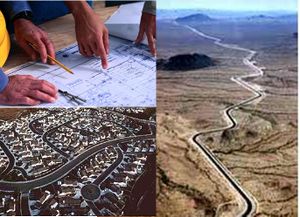Stakeholder Page- Arizona
Contents
- 1 LATEST - Arizona's Colorado River Shortage Preparedness Workshop
- 2 Arizona's Water Management Background
- 3 Water Supplies
- 4 Arizona Water Management
- 4.1 Surface Water Rights
- 4.2 Groundwater Management
- 4.3 Assured Water Supply Program
- 4.4 Conservation Requirements for Large Municipal Water Providers
- 4.5 Conservation Requirements for Agriculture
- 4.6 Conservation Requirements for Industries
- 4.7 Underground Storage and Recovery Program
- 4.8 Water Rights and Permits
- 4.9 Well Requirements and Reporting
- 5 Conservation
- 6 Useful Resources
LATEST - Arizona's Colorado River Shortage Preparedness Workshop
Workshop Materials - Arizona's Colorado River Shortage Preparedness Workshop Materials
Arizona and its water users are prepared to handle the effects of the current drought and impending potential Colorado River shortage declaration which may occur as early as 2016, although more likely in 2017. These conditions are not unexpected. Arizona has been proactively building resilience and implementing innovative water management strategies to secure dependable water supplies.
If shortage is declared in the near term, Arizona cities, towns, industries, mines and tribes using Central Arizona Project water will not see a reduction in their Colorado River supplies. On river municipalities, industrial users and agricultural water users in the Yuma area have the highest priority on the Colorado River system and will not be impacted.
A shortage declaration in the near term will eliminate CAP water supplies to the Arizona Water Banking Authority, a portion of the CAP water supply for groundwater replenishment, will impact agricultural users in central Arizona and may cause an increase in CAP water rates.
Arizona's Water Management Background
With more than 125 years of experience in adapting to one of the most arid climates in the United States and due to our junior priority status on the Colorado River, Arizona has been proactively building resilience and implementing innovative water management strategies to secure dependable water supplies for our future.
Arizona’s population has grown steadily over the years, to more than 5 times and our economy has ballooned to more than 17 times that in 1955, however, through significant investments in conservation, reuse and infrastructure, our water use is essentially the same as it was more than half a century ago.
Arizona leads the nation in the implementation of water efficient reuse programs. More than 95% of treated wastewater generated within Central Arizona (including areas served by the Central Arizona Project and the Salt River Project) serve beneficial uses including agriculture, municipal, groundwater recharge, power generation, industrial, and turf irrigation.
These water supplies support ecologically vital wetland restoration that benefits our unique southwestern flora and fauna, as well as helping to achieve the State of Arizona’s water management goal of Safe-Yield for the Phoenix and Tucson Groundwater Basins.
Water Supplies
Arizona’s water supplies include water from the Colorado River (including Central Arizona Project Water); instate surface water, groundwater and reclaimed water or effluent. Water supply availability and use varies substantially throughout the State’s planning areas. While groundwater levels in wells may vary over time, groundwater is generally a reliable water supply in most parts of the state while in-state surface water supplies may fluctuate widely from year to year due to precipitation variability. Effluent reuse is increasing and although is represented just 3% of the total water supply in Arizona; it was an important supply in some planning areas.Colorado River
• Arizona has an annual allotment of 2.8 maf of Colorado River water for consumptive use.
• Of the state’s total Colorado River allotment, over 1.3 maf is available for use by municipal, industrial and agricultural users along the Colorado River in the Upper and Lower Colorado River planning areas.
• Central Arizona Project annually delivers an average of 1.5 maf Colorado River water.
The Arizona Water Banking Authority (AWBA) was established in 1996 to store the unused portion of Arizona’s annual allocation of the Colorado River water. By storing this unused water, the AWBA secures a dependable water supply. Each year, the AWBA pays the delivery and storage costs to bring Colorado River into Central and Southern Arizona through the CAP Canal. The water is stored underground in existing aquifers or is used by irrigation districts in lieu of pumping groundwater. For each acre-foot store, the AWBA accrues credit that can be redeemed in the future when Arizona’s communities, Indian tribes or neighboring states need this backup water supply.
Surface Water
Arizona surface water supplies derive chiefly from snow along the Mogollon Rim and high elevation mountains of east central Arizona and western New Mexico. The Salt, Verde and Gila rivers are essential supplies for water users in central Arizona. The Salt River Project (SRP), through the Salt River Valley Water Users’ Association, annually delivers a total of almost 1 maf of surface water from the Salt and Verde rivers and groundwater to its service area in the Phoenix AMA.
Groundwater
With the exception of the Lower Colorado River and AMA planning areas, groundwater is the primary water supply utilized for cultural uses, accounting for approximately 43% of the state’s total water supply annually during 2001-2005.
Reclaimed Water
Effluent has met up to 8% of the municipal demand and 27% of the agricultural demand in the Eastern Plateau Planning Area and 28% of the Industrial demand in the AMA planning area. Of the 53% of total facilities for which treatment volumes and reuse data are available, 53% of that effluent has been reused primarily for turf irrigation, groundwater recharge, agricultural irrigation and for cooling purposes at the Palo Verde Nuclear Generating Station in the Phoenix AMA.
The highest percentage of reuse is in the Prescott AMA where 91% of the treated effluent is either recharged or used directly for golf course irrigation.
Arizona Water Management
Surface Water Rights
Early in its history, Arizona adopted the doctrine of prior appropriation to govern the use of surface water. The doctrine is based on the tenet of “First in time, First in right”.
“First in time, First in right” means that the person who first puts the water to a beneficial use acquires a right that is better than later appropriators of water. Prior to June 12 1919, a person could acquire a surface water right simply the water to a beneficial use and posting a notice.
One June 12, 1919 the Arizona surface water code was enacted. This law provides that a person must apply for and obtain a permit in order to appropriate surface water.
Arizona follows a bifurcated system where surface water is regulated separately from groundwater
Groundwater Management
The 1980 Arizona Groundwater Code recognized the need to aggressively manage the state’s finite groundwater resources to support the growing population and economy. Areas with heavy reliance on groundwater were identified and designated as Active Management Areas (AMAs). AMAs were established to provide long term management and conservation of their limited groundwater supplies.
Assured Water Supply Program
Regulations under this program limit the use of ground-water by new subdivisions in an AMA. Before land can be subdivided, either the developer must demonstrate a 100-year assured water supply for the subdivision or show that the subdivision will be served water by a municipal water provider who has demonstrated a 100-year assured water supply for its service area.
Conservation Requirements for Large Municipal Water Providers
Large municipal providers (cities, towns, private water companies and irrigation districts) are assigned an annual total Gallons Per Capita Per Day requirement or are regulated under alternative programs that require the implementation of conservation measures. System losses are not to exceed 10% annually.
Conservation Requirements for Agriculture
Irrigated agriculture cannot be expanded beyond acreage irrigated during the late 1970s. Each farm (Irrigation Grandfathered Right) is assigned a maximum annual groundwater allotment or is enrolled in a best management practices program. Irrigation distribution system losses are not to exceed 10%.
Conservation Requirements for Industries
In AMAs, certain industries that have their own ground-water rights are defined as industrial water users. Examples include golf courses, dairies, mines and power plants. Regulations for these water users include annual conservation allotments, design limitations and the implementation of best management practices.
Underground Storage and Recovery Program
Established in 1986, this program allows surplus supplies of water to be stored underground and recovered later. (Storing excess water underground is referred to as artificial recharge.) This program was further refined in 1994 by the Underground Water Storage, Savings, and Replenishment Act.
Water Rights and Permits
Within an AMA, an authority (legal right or permit) is required in order to pump groundwater from non-exempt wells (pump more than 35 gallons per minute). The rights and permits required include grandfathered rights, service area rights, and withdrawal permits. Each type of permit or right is subject to certain conditions, particularly as to the quantity and purpose of the groundwater use.
Well Requirements and Reporting
In addition to standards for construction and spacing, all non-exempt wells must use approved measuring devices and report annual groundwater withdrawals to the ADWR. In general, exempt wells (pump 35 gallons per minute or less) may not be drilled within 100 feet of the distribution system of a municipal water provider that has a Designation of Assured Water Supply for its water service area.
Conservation
To help Arizonans learn how to reduce water use, Arizona Department of Water Resources offers an assembly of tools to assist residents, businesses, communities and water providers in the design and implementation of comprehensive and proven conservation strategies.
Technologies
The rapid development of technologies both new and improved will help all water users be more efficient. This section describes current and new technologies that can reduce water and energy consumption and associated costs. However, even the best technology becomes inefficient without implementation of proper operation and maintenance practices. For tips on how to improve water-use behavior, please see Water Conservation Tips for Arizona Residents. For information about facility water-use efficiency, developing facility water management plans and audits.
Water Planners and Providers
Some water providers in the state are required to conserve but all water providers are encouraged to conserve.
- Conservation Tools for Water Planners and Providers
- Conservation Planning Information
- Programs, Resources and Organizations
Residential
Residential water use includes water used indoors (bathing, cooking, cleaning, etc.) and water used outdoors (watering plants, swimming pools, washing cars, etc.) In Arizona, about 25% of the water supply is for municipal use, and most of this is residential. Each person uses about 100 gallons per day, and as much as 70% of that water is used outdoors, especially in summer. Residents that incorporate water efficiency into everyday life will help to preserve water for future generations.
The following information is designed to help Arizona residents use water wisely and efficiently indoors and out.
Commercial, Industrial & Institutional
In Arizona, approximately 15% of the water supply is for commercial, industrial and institutional uses. This includes water used by commercial buildings, hospitals, schools, golf courses, parks, power plants, and other industries. Some of these entities receive municipal water supplies, while others have rights to wells and pump their own water. Arizona businesses, industries and institutions are encouraged to conserve the water they use, whether or not they are regulated by state law.
- Summary of ADWR Conservation Requirements for Industrial Water Users
- Conservation Tools for Commercial, Industrial and Institutional Facilities
- Programs, Resources and Organizations
Agriculture
Irrigated agriculture is the largest use of water in Arizona, using about 68% of the available water supply. In the past, this percentage was as high as 90%; reductions have been the result of both urbanization of agricultural lands and heavy investment by the irrigated agriculture industry in conservation measures both on-farm and in delivery systems.
These investments and practices help growers stretch water supplies, increase productivity and profits, manage situations of water supply scarcity, reduce energy costs and meet the conservation requirements of Arizona's 1980 Groundwater Code.
The links below provide water-efficiency information and assistance for Arizona farmers and ranchers.
- Best Management Practices
- Computer-Based Tools
- Educational Information
- Programs, Resources and Organizations
Landscape Professionals
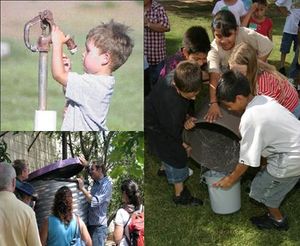
- Training and Certification
- Plant Lists and Landscaping
- Irrigation and Water Harvesting
- Programs, Resources and Organizations
Water Conservation Education and Outreach
The Arizona Department of Water Resources believes in lifelong learning and is committed to promoting responsible water stewardship through education. ADWR supports partnerships, sponsors educator workshops, and participates in educational events in an effort to bring quality water education programs to Arizona.
The links below provide water education information that will assist students, educators and other adults in learning about water in Arizona and discovering why it is so important to protect this crucial resource.
- Activities and Resources for Students
- Resources and Workshops for Educators
- Water Education for Adults
